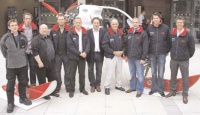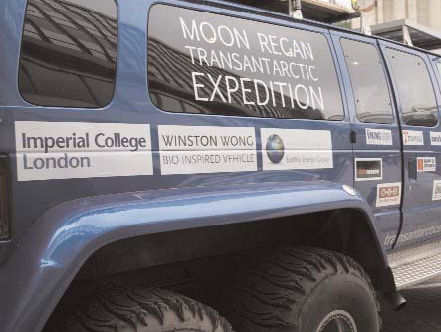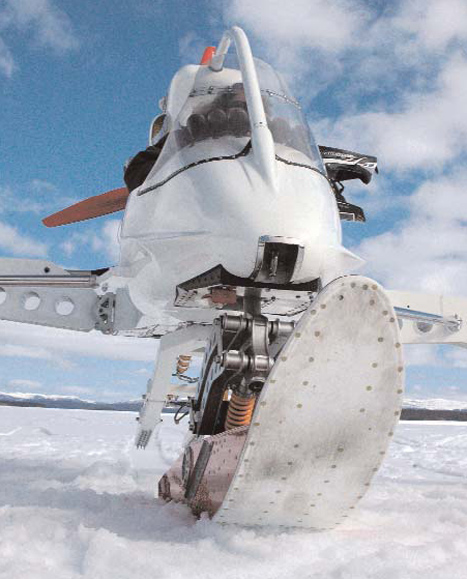Attitudes towards the Antarctic have changed. Robert Falcon Scott called the continent that would claim his life ’a dreadful place’. Apsley Cherry-Gerard, another member of Scott’s party, described his 60-mile foray to find and collect penguin eggs in a book called The worst journey in the world. And now, a British-led scientific expedition is returning to Antarctica with a plan to cross the continent from west to east, and then back again.
Talk to the team behind this latest foray to the icecap, the Moon-Regan Transantarctic Expedition, and you’ll get a quite different point of view to that of those early 20th century explorers. ’The cleanest, most environmentally friendly part of the planet’, they call it; ’the world’s cleanest, coldest laboratory’; ’the biggest wind tunnel you could ever play with’; ’a pristine environment’. The expedition’s co-leader, Andrew Moon, describes the South Pole itself - or, rather, the large US research base located there - as ’an opportunity for some rest and recreation’.
The team is taking its expedition very seriously, though - and rightly so. The 3,600-mile Moon-Regan expedition, whose elements were coming together in Buenos Aires, Argentina, as The Engineer went to press, is only the third attempt to cross the Antarctic continent. The 11-strong team will take three vehicles on the journey, equipped with monitoring equipment and sensors for an extremely wide range of science. Two of these vehicles are huge, six-wheel, all-wheel-drive mobile labs, converted from Ford Econoline vans. The other looks like nothing else on Earth.

Moon-Regan is, therefore, very much a multipurpose expedition, North said. Five years in the planning, it will carry experiments from eight departments at Imperial. ’It’s been a massive team effort to get us to this point and, for us, it’s been very compressed in terms of the kind of experiments we can do. Chances to work in this environment are very, very rare, and we have to make the most of them.’
North is a lecturer in transport for environmental planning from Imperial’s civil engineering department and is one of two scientists undertaking the journey. He’s more usually to be found testing air quality between the Natural History and Victoria and Albert museums. ’This,’ he said with fine understatement, ’is a bit more glamorous and exciting than my normal work.’
“Two of the vehicles are huge, six-wheel, all-wheel-drive mobile labs converted from Ford Econoline vans. The other looks like nothing else on Earth”
The BIV, North explained, is designed as an ’agile pathfinder’ for the expedition and, running on bioethanol, it will also be the first biofuel-powered vehicle to reach the South Pole. ’It’s both a scout and it’s designed to see how we can reduce our impact on the environment,’ he said.
The vehicle was conceived, designed and built by Lotus Engineering, and has undergone several upgrades after testing in Sweden to bring its performance up to the levels needed for Antarctica. Lighter, faster and more manoeuvrable than the SSVs, it is intended to glide over snow and ice, supplying data on the performance of the biofuel, while also using cameras and a ground-penetrating radar to study the structure of the ice itself. ’We’re looking at the solar radiation, the incident and the reflected light, with sensors that show how it’s distributed across the electromagnetic spectrum,’ North explained. ’The difference between incident and reflected tells us which wavelengths, and therefore energies, the ice is absorbing and that’s very important for glaciology and predicting how the ice sheets will evolve.’
Many of these types of experiments have been performed before - Antarctica is, after all, home to several permanent scientific stations.
However, North said, the journey there and back across Antarctica will allow continuous measurement in a way that hasn’t been possible before. ’You often get a series of measurements in one place, but we can monitor all the way across the continent in a variety of conditions,’ he explained.
The terrain the expedition will move over is rough. Although the route has been carefully surveyed and planned to avoid obstructions such as crevasse fields near its start point, Union Glacier, the ice surface of the Polar Plateau - the 3,000m-high, 1,000km-wide highland in the centre of the continent - is carved into ripples and waves like a frozen ocean. ’The wind forms these waves, called sastrugi, and some of them are huge,’ North said. ’The support vehicles may look big here, but they’re like little toy cars moving around in that landscape.’
Antarctica is the world’s biggest wind tunnel and get to will work at the bottom of itRobin North, Moon-Regan Expedition Science Lead
Expedition co-leader Andrew Moon took one of the two SSVs to Antarctica in 2005 for a proof-of-concept run. ’We went from Patriot Hills, which is near our start point this time, to the Pole in 69 hours, but we had our foot down - we won’t go that fast this time,’ he said. ’We averaged about 15mph. It comes down to surface conditions - in a smooth bit you’ll do about 40mph. But there aren’t many smooth bits.
Antarctica’s a pretty rough place.’

The BIV can be man-hauled over large sastrugi if necessary, Moon added. ’Sometimes the team will depend on the ice vehicle; other times it’ll be the other way around.’
The BIV is also equipped with a highly sensitive satellite-positioning system. ’We’re actually using that as a sensor,’ North said. The readings from this system will give an insight into how the ionosphere - the section of the atmosphere from about 50 to 1,000km above the Earth’s surface -distorts radio signals as they move through its various layers. ’The correlations between that and the atmospheric radiation measurements will, we hope, tell us a lot about that system as a whole. It also tells us about the composition of the atmosphere and how it’s behaving, and the extent of the hole in the ozone layer.’
The driver of the vehicle will be one of the subjects for continuous physiology monitoring, using equipment provided by Imperial’s spin-out Toumaz Technology, whose founder, Prof Chris Toumazou, is the director of the college’s Institute of Biomedical Engineering. The equipment uses low-power-consumption chips that will transmit heart rate and body-position information - via three-axis accelerometry - via wireless links to the SSVs.
’It’s also going to send information back to us continuously via satellite,’ Toumazou explained. ’This means we can perform analyses of conditions such as hypothermia, which will give us information about early detection.’ The two sets of data will allow the team to extrapolate information about sleep patterns, stress under different conditions and energy expenditure. ’We’ll have one person wearing the kit each day, doing a battery of tests, and they’ll rotate it around the next day,’ he said. ’That way each person will have a full day’s monitoring throughout the expedition. We’ll see how they adapt and how different tasks affect their physiology.’
Meanwhile, the team will be conducting a whole battery of other experiments. The SSVs will analyse samples of surface snow and ice to determine the accumulation of heavy metals and persistent organic compounds, giving clues to how global industry and air pollution has affected the environment of this continent. They will also monitor emissions from the BIV to study its performance.
Among the team’s other tasks will be to locate and collect samples of cosmic dust and meteorites. ’Antarctica is a great place for that,’ said North. Meteorites tend to collect in so-called ’blue ice’ regions, where snow compressed over centuries into ice is pushed against obstructing rocks and forced to the surface. ’The meteorites get accumulated over time and they’re uncontaminated. When we find a blue ice area, we’ll take lots of photos to document their position and orientation, then we’ll collect them under sterile conditions and bring them back to the Natural History Museum for characterisation and study. With every meteorite we get a little record of the history and origins of the Solar System, the Moon and Mars.’
Still more research comes from the college’s aeronautical department. ’They have a mast that allows us to look at the near-surface structure of the airflow, which tells us a lot about skin friction and surface properties, in terms of reducing drag on aircraft and making them work better,’ North said. ’Antarctica is the world’s biggest wind tunnel and we get to work at the bottom of it.’
Many of the types of experiment that North will be conducting are familiar to him, but the surroundings make it very different. ’It is an extension of my technical work into a new domain, but the rules of the game are very different,’ he said. ’And a lot colder.’
back story - 40 days and 40 nights
If completed within the six-week target, the Moon-Regan team will break the Antarctic crossing record
The Moon-Regan Transantarctic Expedition aims to cross the Antarctic and return to its start point in around 40 days. The first crossing, achieved by Sir Vivian Fuchs and Sir Edmund Hillary in 1958-59, used adapted Massey Ferguson tractors and took more than 100 days. The second, by Ranulph Fiennes’ 1980 Transglobe Expedition, used air-supported snowmobiles and took around 60 days.
Starting from the Union Glacier base on the west coast of the continent on 16 November, the team will head east to avoid crevasse fields, then ascend onto the Antarctic plateau via the Explora Escarpment and turn south towards the South Pole, reaching Amundsen Base on around 21 November. Leaving two days later, the route heads north through the Trans-Antarctic Mountain Range onto the Leverett Glacier, which descends in a gentle slope to the Ross Ice Shelf, which leads to the finish point at McMurdo Sound - the team hopes to reach there by 30 November.
The team will start their return trip on 3 December. They will arrive back at the Pole around 10 December and reach Union Glacier on around 15 December.
’Each SSV can carry 1,900 litres of fuel, which is enough to get us from Union to the Pole,’ Moon said. ’There are fuel caches at Union, the Pole and McMurdo, so we can refuel three times over the course of the trip. We won’t be going too fast - the purpose of this trip is science, not record-breaking - but we will break the record for Antarctic crossing.’
in depth - cool running
The Winston Wong ice vehicle has been modified to prepare it for the harsh Antarctic conditions

The Winston Wong Bio-Inspired Ice Vehicle carries the name of the Expedition’s main benefactor, a Taiwanese semiconductor tycoon who gained his first degree in physics and a subsequent PhD at Imperial. Since Lotus’s original design, the BIV has undergone some major modifications.
During testing, the original BMW 1150 motorbike engine was found to be underpowered. The Imperial team replaced it with a Rotax 914 aircraft engine, a four-cylinder, 1.2-litre four-stroke unit adapted to run on E85 bioethanol. The engine develops 115hp and is capable of pushing the 700kg vehicle at a top speed of 84mph.
’We also reworked the front suspension to make it stronger and we’ve done some work to protect the driver better,’ North added. ’We’ve provided heated clothes and we have some skirts to go around the sides to protect against snow spray.’
The two SSVs each weigh 4.7 tonnes, riding on six 44in-high, 21in-wide wheels, which can be driven independently. Part of the reason for the expedition is to prove that wheeled vehicles are more suited to the terrain than the previous continent-crossing expeditions, which used tracked vehicles. The 7.3-litre diesel engines will run on A1 jet fuel since, as Andrew Moon explained, standard diesel has a tendency to freeze at low temperatures. The scientific equipment on board is powered by solar panels.





Project to investigate hybrid approach to titanium manufacturing
What is this a hybrid of? Superplastic forming tends to be performed slowly as otherwise the behaviour is the hot creep that typifies hot...